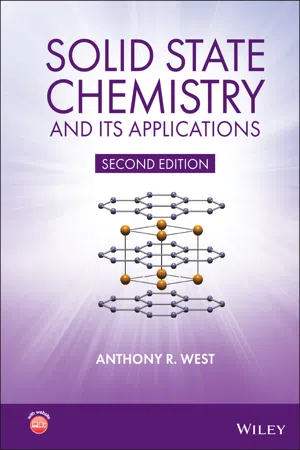
- English
- ePUB (mobile friendly)
- Available on iOS & Android
Solid State Chemistry and its Applications
About this book
SOLID STATE CHEMISTRY AND ITS APPLICATIONS
A comprehensive treatment of solid state chemistry complete with supplementary material and full colour illustrations from a leading expert in the field.
Solid State Chemistry and its Applications, Second Edition delivers an advanced version of West's classic text in solid state chemistry, expanding on the undergraduate Student Edition to present a comprehensive treatment of solid state chemistry suitable for advanced students and researchers. The book provides the reader with an up-to-date account of essential topics in solid state chemistry and recent developments in this rapidly developing field of inorganic chemistry.
Significant updates and new content in this second edition include:
- A more extensive overview of important families of inorganic solids including spinels, perovskites, pyrochlores, garnets, Ruddlesden-Popper phases and many more
- New methods to synthesise inorganic solids, including sol-gel methods, combustion synthesis, atomic layer deposition, spray pyrolysis and microwave techniques
- Advances in electron microscopy, X-ray and electron spectroscopies
- New developments in electrical properties of materials, including high Tc superconductivity, lithium batteries, solid oxide fuel cells and smart windows
- Recent developments in optical properties, including fibre optics, solar cells and transparent conducting oxides
- Advances in magnetic properties including magnetoresistance and multiferroic materials
- Homogeneous and heterogeneous ceramics, characterization using impedance spectroscopy
- Thermoelectric materials, MXenes, low dimensional structures, memristors and many other functional materials
- Expanded coverage of glass, including metallic and fluoride glasses, cement and concrete, geopolymers, refractories and structural ceramics
- Overview of binary oxides of all the elements, their structures, properties and applications
Featuring full color illustrations throughout, readers will also benefit from online supplementary materials including access to CrystalMaker® software and over 100 interactive crystal structure models.
Perfect for advanced students seeking a detailed treatment of solid state chemistry, this new edition of Solid State Chemistry and its Applications will also earn a place as a desk reference in the libraries of experienced researchers in chemistry, crystallography, physics, and materials science.
Frequently asked questions
- Essential is ideal for learners and professionals who enjoy exploring a wide range of subjects. Access the Essential Library with 800,000+ trusted titles and best-sellers across business, personal growth, and the humanities. Includes unlimited reading time and Standard Read Aloud voice.
- Complete: Perfect for advanced learners and researchers needing full, unrestricted access. Unlock 1.4M+ books across hundreds of subjects, including academic and specialized titles. The Complete Plan also includes advanced features like Premium Read Aloud and Research Assistant.
Please note we cannot support devices running on iOS 13 and Android 7 or earlier. Learn more about using the app.
Information
1
Crystal Structures, Crystal Chemistry, Symmetry and Space Groups
1.1 Unit Cells and Crystal Systems
Table of contents
- Cover
- Table of Contents
- Title Page
- Copyright Page
- Dedication Page
- Preface
- Companion Website
- Biography
- Solid State Chemistry, an Overview of the Discipline: Chemistry – Solid State Chemistry – Materials Chemistry – Materials Science and Engineering
- 1 Crystal Structures, Crystal Chemistry, Symmetry and Space Groups
- 2 Crystal Defects, Non‐stoichiometry and Solid Solutions
- 3 Bonding in Solids
- 4 Synthesis, Processing and Fabrication Methods
- 5 Crystallography and Diffraction Techniques
- 6 Other Characterisation Techniques: Microscopy, Spectroscopy, Thermal Analysis
- 7 Phase Diagrams and Their Interpretation
- 8 Electrical Properties
- 9 Magnetic Properties
- 10 Optical Properties: Luminescence, Lasers and Transparent Conductors
- 11 Heterogeneous Materials, Electroceramics and Impedance Spectroscopy
- 12 Thermal and Thermoelectric Properties
- 13 Functional Materials: Some Important Examples
- 14 Glass
- 15 Structural Materials: Cement, Refractories and Structural Ceramics
- 16 Oxides of the Elements, Their Properties and Uses
- Appendix A: Appendix AInterplanar Spacings and Unit Cell Volumes
- Appendix B: Appendix BModel Building
- Appendix C: Appendix CGeometrical Considerations in Crystal Chemistry
- Appendix D: Appendix DThe Elements and Some of Their Properties
- Appendix E: Appendix EThe 32 Crystallographic Point Groups
- Appendix F: Appendix FThe Arrhenius Equation for Ionic Conductivity
- Appendix G: Appendix GA Guide to the Use of Electrode Potentials
- Further Reading
- Questions
- Index
- End User License Agreement